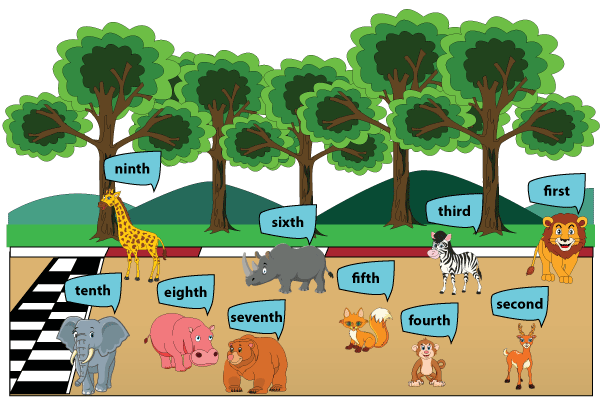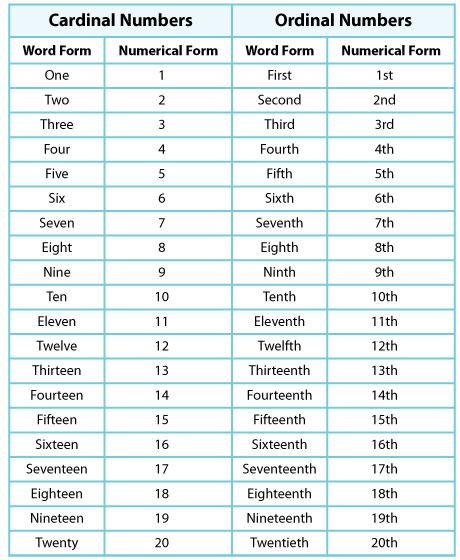Ordinal Numbers | Definition, Facts, and Examples
- Math Lessons >
- Ordinal Numbers
What are Ordinal Numbers?
An ordinal number is a number that tells the position of something in a sequence or a list. Let’s celebrate Jungle Sports Fest, the most-awaited event of the year, and in the process learn ordinal numbers.
Jungle Sports Fest
The jungle is abuzz with animals cheering for their friends. The animals have sprinted as fast as they could and reached the finish line. Here are the results.

Here you have two questions to think and answer.
1) How many animals participated in the run?
2) Who made it to the tenth spot?
To answer the first question, you’d count the participants 1, 2, 3,… and obviously say 10.
And to answer the next, you would look at the positions and instantly say “the elephant".
Note: The word “ten” talks about how many animals participated in the run while the word “tenth” refers to the animal in that position in relation to the other animals.
The counting numbers that indicate the quantity of items on a list are called
cardinal numbers.
The numbers that denote the position or rank of an item on a list are called
ordinal numbers.
Word Form and Numerical Form of Ordinal Numbers
The very name “ordinal numbers” says that they have a numerical form. How do we represent them as numerals? To know how to represent ordinal numbers as numerals, we must understand their relation with cardinal numbers first. Most cardinals become ordinals when accompanied by the suffix “-th”.
Examples
Cardinals
Ten
Fifteen
Thirty-seven
Ordinals
Tenth
Fifteenth
Thirty-seventh
There Are Exceptions!
Apart from the suffix "-th", there are a few places where 3 more suffixes: "-st", "-nd", "-rd" come into play. Let's take a look!
Cardinals
One
Two
Three
Ordinals
First
Second
Third
(This comes with the suffix ”-st”.)
(This comes with the suffix “-nd”.)
(This comes with the suffix “-rd”.)
And the cardinal names with a one, two, or three at the end have their ordinal names as follows.
Cardinals
Twenty-one
Forty-three
Seventy-two
Ordinals
Twenty-first
Forty-third
Seventy-second
Note: In certain cases, the spelling of the cardinal is modified to accommodate the suffix.
Cardinals
Five
Nine
Twelve
Twenty
Ordinals
Fifth
Ninth
Twelfth
Twentieth
Now, coming to the numerical representation of ordinals, it’s nothing but the cardinal number along with the appropriate suffix. Here’s a table illustrating the first twenty ordinal numbers both in written and numerical forms.
First Twenty Cardinals and Ordinals - Table

It’s Your Turn Now!
1) Which flower is in the sixth place from the left?

 is in the sixth place from the left.
is in the sixth place from the left.
2) In which position is the calculator from the right?

The calculator is in the 5th position from the right.
3) Write the ordinal numbers and names of the cardinals below.
i) 25
ii) 70
iii) 52
iv) 91
v) 83
A Quick Recap
Ordinal numbers represent the position of something in a list.
Just like the cardinals have numerical and word forms, ordinals also have both forms.
To convert a cardinal number to an ordinal number, we need to add the suffixes like -st, -nd, -rd, or -th to it.

Plunge into practice with our free printable Ordinal Numbers worksheets!

